U.S. Department of Transportation
Federal Highway Administration
1200 New Jersey Avenue, SE
Washington, DC 20590
202-366-4000
Sign up to have Safety Compass delivered right to your inbox!

Best for printing: PDF Version (1.5 MB)
In this issue:
A Message from the FHWA Associate Administrator for Safety, Cheryl Walker
What's New
Monthly Spotlights Archive: None of Us Can Reach Zero Traffic Deaths Alone
Safety-Driven Changes and Improvements
Learning Together
Strengthening the Linkages between Operations and Safety
Helping One Another Reach Zero: Cities of Richmond and Tampa
Data and Analysis
Roadway Safety Data Improvement Program Technical Assistance Supports States' Roadway Data Programs
New Resource Roundup
Motorcycle Safety Noteworthy Practices: Infrastructure and Engineering
New FHWA Resources for Crash Reduction
New Intersection Informational Guide for Pedestrians and Biyclists Released
Announcements
Now Available: "Improving Safety for Pedestrians and Bicyclists Accessing Transit" Guide
2020 State Safety Performance Target Assessment Results Now Available

Cheryl Walker, Associate Administrator for Safety.
Hello to all our safety champions, and welcome to the fall 2022 Safety Compass Newsletter! Our shared priority is to make our transportation system safe for all people, so that each person arrives at their destination safely. The only acceptable number of deaths and serious injuries on our roadways is zero.
To help us reach zero, the new SS4A program provides dedicated funding to support investment in meaningful Safe System initiatives. This discretionary grant program, part of the Bipartisan Infrastructure Law (BIL), and administered by the U.S. Department of Transportation (USDOT), supports local initiatives to prevent transportation-related deaths and serious injuries on roads and streets. SS4A will provide $5 billion over the next 5 years for regional, local, and Tribal safety-related plans and projects. In fiscal year 2022, up to $1 billion is available. This SS4A grant program supports Transportation Secretary Pete Buttigieg's National Roadway Safety Strategy (NRSS), which directs attention and funding to address urgent and often overlooked safety needs.
The SS4A program provides funding for two types of grants: Action Plan Grants (at least 40 percent of funds) and Implementation Grants (up to 60 percent of funds). Examples of activities that could be conducted as part of an Action Plan Grant and Implementation Grant are provided on the SS4A web page.
The SS4A web page also has a wealth of other resources that will help agencies prepare their applications. We encourage agencies that have never before applied for Federal funding from USDOT to consider submitting an application. Take a look at the website, review the frequently asked questions (FAQs), watch the webinars, and check out the fact sheets with step-by-step instructions. Consider partnering with eligible applicants within your region who have established financial relationships with USDOT and who have knowledge of Federal grant administration requirements.
The deadline for applications for the 2022 grants is September 15, 2022. Award announcements are expected to be made by the end of calendar year 2022 or in early 2023.
SS4A gives us the opportunity to move out of our transportation siloes and to engage a diversity of stakeholders in the work of investing in safe, sustainable, equitable, and accessible mobility options and public roads. This program provides an opportunity to support enduring roadway safety projects and programs that prioritize walking, biking, and transit use, as well as investing in underserved communities. The projects supported by SS4A grants will truly move us toward our goal of zero deaths and serious injuries on our Nation's roads.
By Norah Ocel, P.E., PMP®, FHWA Office of Safety, Partnerships-Engagement Collaboration

Roadway safety champions web page. (Source: FHWA)
Partnerships and collaboration among roadway safety stakeholders are vital to achieving our long-term goal of zero deaths on our Nation's roadways.
When Secretary Buttigieg launched NRSS in January 2022, he underscored the importance of USDOT's partnerships by stating, "We need partners in State and local governments," and adding that "none of us can do this alone." Secretary Buttigieg was referring to the ambitious shared goal of reaching zero deaths on our roadways and streets, inside and outside the vehicle. USDOT has adopted the Safe System Approach and is promoting its use by State, local, and Tribal governments. Transportation agencies must commit to designing roads that promote safety for all road users, make data-driven decisions, and incorporate Proven Safety Countermeasures.
To highlight our partners that have demonstrated an exceptional commitment to roadway safety, the Office of Safety in 2021 launched Roadway Safety Champions — Our Partners for Zero Traffic Deaths. The website includes a monthly spotlight on a State or local transportation agency's noteworthy efforts to advance roadway safety. A NEW Spotlights Archives section of the website includes previous monthly spotlights, so it's never too late to find great examples. Spotlight topics include working with community stakeholders; using curve safety assessment devices; identifying the right locations for installing high friction surface treatments (HFST); using a Safe System Approach within the Highway Safety Improvement Program (HSIP); and shaping standards, policies, and practices because of a safety implementation plan.
FHWA Office of Safety encourages you to visit Spotlights Archives and learn what many roadway safety champions are doing.
For more information, please contact Norah Ocel at norah.ocel@dot.gov.
By Esther Strawder, FHWA Office of Safety
Signed on November 15, 2021, BIL is landmark legislation that will benefit our transportation system for years to come. FHWA has several programs that are directly affected by BIL. The Railway-Highway Crossing Program (Section 130 Program) is one such program.
The Section 130 Program remains a State administered, data-driven, Federally funded program. But thanks to BIL, it now offers more flexibility and a higher Federal share. BIL updates to the Section 130 Program also improve some of the set-aside allowances, such as increasing the allocations for data collection and projects beyond protective devices. BIL also clarifies that funds are eligible for projects to reduce trespassing at rail crossings. Implementation of the new BIL revisions were effective as of October 1, 2021.
Guidance for BIL updates to the Section 130 Program is now available online.
For more information, please contact Esther Strawder at esther.strawder@dot.gov.
By Rosemarie Anderson, FHWA Office of Safety
The goal of the Safety Circuit Rider (SCR) Program is to reduce the frequency and severity of roadway crashes by providing safety-related support to agencies responsible for local and Tribal road safety. SCR programs are typically operated by qualified safety professionals. These individuals are referred to as safety circuit riders, and they assist local and Tribal agencies with their safety efforts. The SCR Program has expanded, and as of 2022 more than 20 States have developed SCR programs or positions. States providing safety-related technical assistance similar to an SCR program include Arizona, Idaho, Nebraska, New Jersey, New York, North Dakota, Pennsylvania, South Dakota, Tennessee, West Virginia, and Wisconsin.
The SCR Program is an integral part of USDOT's NRSS, a roadmap for addressing the national crisis in roadway fatalities and serious injuries. The roadmap provides concrete steps to address and prevent deaths and serious injuries while working toward the ambitious, long-term goal of achieving zero roadway fatalities. The zero goal requires action from all levels of government so that road users can be safe when traveling on the Nation's roadways. This, too, is a goal of SCR programs, as they have extended their reach to traditional and non-traditional safety partners.
The SCR Program in most States is administered through the Local Technical Assistance Program (LTAP). For some, such as Colorado, the program is administered through the State department of transportation (DOT). The safety circuit riders act as a conduit to local and Tribal agencies by performing tasks in training, technology transfer, and technical assistance.
Training
Training by SCR focuses on road safety and is typically provided to local, State, and Tribal agencies through LTAP. Training topics include low-cost safety improvements, signing and pavement markings, work zone safety, flagger training, safety analysis, road safety audits (RSAs), and HSIP project development.
The Connecticut SCR Program created a Safety Academy, which provides free training on local and Tribal road safety topics, and a free Safety Champion program, which enables local and Tribal agencies and DOT staff to earn credit for taking the trainings. Several SCR programs offer a Road Scholar Program. This program includes a series of classes for the participant to be certified. States offering a Road Scholar Program include Colorado, Connecticut, Indiana, Kentucky, Louisiana, Minnesota, Missouri, New Hampshire, Nevada, North Carolina, Ohio, Pennsylvania, and West Virginia.
Technology Transfer
Technology transfer involves introducing agencies to new and innovative technologies, products, and methods with the goal of making them standard practice. Technology transfer involves peer exchanges, workshops, conferences, and equipment loan programs. Equipment loan programs provide items such as retroreflectometers, ball bank indicators, and radar speed detection equipment to local and Tribal agencies.
The following are examples of technology transfer activities:
Technical Assistance

Technical assistance. (Source: FHWA)
Technical assistance includes safety-related services to advance safety on local and Tribal agencies' roadway systems. Technical assistance is especially important for local and Tribal agencies that do not employ a full-time engineer. Popular technical assistance includes data collection, the use of various types of equipment, data analysis, producing crash trends, and identifying routes and roadway features to address through safety improvements, and RSA field reviews.
Several SCR programs are assisting local and Tribal agencies with the development of LRSPs. The Colorado SCR Program assisted with LRSPs by identifying countermeasures with the greatest potential to reduce traffic crashes. Indiana, Ohio, and Alabama's SCR programs provide safety project application assistance to help local and Tribal understand safety project eligibility requirements for safety funding and assist them with completing safety project applications.
Quantitatively assessing the impacts of the SCR Program (reduction in fatalities and serious injuries) can be difficult. There has been a preponderance of qualitative evidence showing SCR Program success and its positive influence on safety culture. Many programs have shown improved safety awareness through increases in:
The Office of Safety recently released Safety Circuit Rider Programs: Working to Reduce Fatalities and Serious Injuries on Local and Tribal Roads. This publication provides an overview of existing SCR programs and includes the following:
For more information, please contact Rosemarie Anderson at rosemarie.anderson@dot.gov.
By Karen Scurry, FHWA Office of Safety
The FHWA Office of Safety developed a series of fact sheets to tell the story of the HSIP. Leveraging robust program data from 2020 and the stories of noteworthy practices, these fact sheets provide practical and actionable information that not only reviews the story of HSIP so far, but also paints a picture for using HSIP in the future.
The Highway Safety Improvement Program – 2020

The Highway Safety Improvement Program – 2020 fact sheet. (Source: FHWA)
Every year, States receive an apportionment of HSIP funding for highway safety improvement projects that are consistent with a State's Strategic Highway Safety Plan (SHSP). How a State uses that apportionment is based on the unique needs of each transportation program, but the use is always in support of the common goal of saving lives with data-driven decisions and strategic planning. The Highway Safety Improvement Program–2020 fact sheet provides high-level information about States' HSIPs, including the number, type, and cost of projects funded via HSIP in 2020. The fact sheet also includes an outline of the HSIP funding process.
Fun fact: In 2020, States obligated more than $5.5 billion to more than 5,300 highway safety improvements.
Keeping Pedestrians Safe with HSIP – 2020
With a 44-percent increase in fatal pedestrian crashes between 2010 and 2019, the ability of HSIP to support projects designed to improve pedestrian safety is another way the program is saving lives.
Fun fact: In 2020, States obligated more than $165 million in HSIP funds to 313 projects focused on pedestrian safety.
Check out the fact sheet for information about the types of pedestrian safety improvements funded via HSIP and an example of how Arlington County, Virginia, is keeping pedestrians safe with HSIP.
Improving Local Road Safety with HSIP – 2020
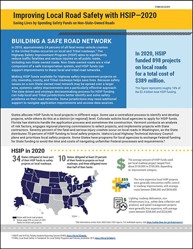
Improving Local Road Safety with HSIP – 2020 fact sheet. (Source: FHWA)
HSIP aims to save lives by spending safety funds on non-State-owned roads. The data-driven and strategic decision-making process for HSIP funding can help local and Tribal jurisdictions better identify and solve safety problems on their road networks. Some jurisdictions may need additional support to navigate application requirements and access data sources.
Fun fact: In 2020, HSIP funded 898 projects on local roads. These local road projects represented 16 percent of the HSIP funding for that year.
States used both centralized and regional processes to allocate the funds to local projects. The Improving Local Road Safety with HSIP–2020 fact sheet includes information about how States allocate HSIP funds to local agencies, key local road safety partners, types of HSIP-funded projects on local roads, and an example of how Georgia is improving local road safety with HSIP.
Advancing Speed Management Strategies with HSIP – 2020
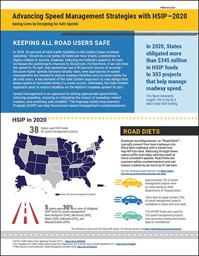
Advancing Speed Management Strategies with HSIP – 2020 fact sheet. (Source: FHWA)
Fun fact: In 2020, 38 States used HSIP funds for speed management projects.
The Advancing Speed Management Strategies with HSIP–2020 fact sheet outlines various types of HSIP-funded speed management projects and a specific example of how Oregon is advancing speed management strategies with HSIP.
Implementing Systemic Safety Improvements with HSIP – 2020

Implementing Systemic Safety Improvements with HSIP – 2020 fact sheet. (Source: FHWA)
A systemic approach to safety saves lives by proactively seeking to prevent crashes before they happen. The HSIP can be used to save lives by identifying risks and implementing low-cost improvements.
Fun fact: In 2020, States obligated 38 percent of HSIP funds to systemic safety projects.
The fact sheet provides additional information about the systemic safety analysis process, types of systemic safety improvements funded with HSIP in 2020, and an example of how Missouri is implementing systemic safety improvements with HSIP.
How Can You Be Part of the HSIP Story?
All States develop and administer HSIPs to best meet their needs. Contact your State DOT to find out how you can save lives in your community.
Do you have an HSIP success story? Share your projects on Facebook, Twitter, and Instagram with #HSIPSavesLives. Stay tuned for 2021 fact sheets that will tell the HSIP story about data, rural road safety, intersections, Proven Safety Countermeasures, and more.
For more information about the HSIP, please contact Karen Scurry at karen.scurry@dot.gov.
By Jim Hunt, FHWA Office of Operations; and Jerry Roche and Anyesha Mookherjee, FHWA Office of Safety
Safety and operations have always had clear interdependencies. A well-operated transportation system is often correlated with strong safety performance. Conversely, a transportation system with few crashes, especially few severe crashes, often performs well from an operations perspective. Specific operations strategies, such as traffic incident management, road weather management, traveler information, queue warnings, and work zone management, are known to improve both safety and operations.
Despite opportunities to expand current capabilities and integrate emerging strategies to address safety more proactively through operations, barriers exist to fully integrating operations and safety in planning, analysis, and operations. For example, the analysis methods in the American Association of State Highway and Transportation Officials (AASHTO) Highway Safety Manual (HSM) do not incorporate daily, hourly, or sub-hourly variations in the road environment. They also do not consider traffic characteristics (flow, density, speed, capacity) that are critical for assessing the safety impacts of operations strategies.
Completed, ongoing, and upcoming FHWA projects led by the Offices of Operations and Safety are finding ways to strengthen the programmatic relationships between operations and safety. This article discusses opportunities for better coordinating and leveraging safety and operations for the benefit of both areas and provides examples of this in current practice.
Identifying Operations Strategies That Support Safety
Through FHWA research and practitioner interviews, the most frequently mentioned strategies that intersect safety and operations are work zone management, traffic incident management, ramp metering, variable speed limits, traffic signals, intersection conflict warning systems, and wrong-way driving countermeasures. By planning and implementing these strategies together, agencies can address safety and mobility needs, mitigate potential impacts, and enhance system safety and mobility at the same time. The Office of Operations is completing a project that identifies operations strategies that address safety concerns (inadequate visibility, excessive vehicular conflicts, speed differential, congestion, excessive speeds, vulnerable users, etc.). The project includes a report on the existing supporting documentation of safety performance impacts. A scan of the Crash Modification Factors (CMF) Clearinghouse revealed operations strategies that have the most support with respect to CMF, shown in the table below.
| Operations Tactics | Number of Studies in CMF Clearinghouse |
|---|---|
| Automated enforcement | 310 |
| Adaptive signal control | 104 |
| Variable speed limits | 29 |
| Dynamic warning signs | 27 |
| Managed lanes | 25 |
Finding Synergies between Operations and Safety in Plans
Including safety objectives in transportation systems management and operations (TSMO) plans and including TSMO strategies in safety plans show that safety and TSMO programs view operations as a tool to improve safety. Multiple State DOTs reported a crossover of operations and safety staff in the development of their TSMO and safety plans. Many State DOT TSMO plans, such as Arizona and Nevada's, explicitly reference safety-themed vision statements, safety data, safety performance metrics, and safety strategies. For an example from a metropolitan planning organization (MPO), the Maricopa Association of Governments (MAG) produces both an operations plan that explicitly references safety and a safety plan that explicitly references operations.
Organizational Structure Considerations
An established organizational structure with formal mechanisms for intra-agency coordination can enable greater interactions among safety and operations staff. This can serve as a basis for integrated actions that improve safety and mobility throughout the transportation system. Organizations with safety and operations in the same unit or division benefit from having a common director and routine interactions with their safety or operations counterparts. Residing in the same unit, however, is not necessary to achieve a significant level of coordination between TSMO and safety. For example, Ohio Department of Transportation (ODOT) and Florida Department of Transportation (FDOT) have separate safety and TSMO divisions or offices, but also have high levels of coordination. States with high levels of coordination often have leadership support, active crosscutting committees, and task forces to improve coordination.
Data Opportunities
Agencies that consider both safety and operations data develop more holistic solutions and strategies to address performance issues. Identifying common safety and congestion hot spots is one of the most frequent practices among State DOTs and MPOs for bringing together safety and operations data. FDOT's operations and safety programs use each other's data to identify hot spots, implement countermeasures, and assist in law enforcement. Arizona Department of Transportation's (ADOT) road safety assessments rely on both safety and operations data to identify issues. New Jersey Department of Transportation's operations office examines historical crash data when evaluating highway locations for part-time shoulder use to better understand the safety context for this TSMO strategy.
Near Miss Identification Safety Systems (N-MISS)

N-MISS intersection diagram. (Source: FDOT)
FDOT is implementing N-MISS, a project that uses traditional and emerging technology and real-time data to detect and analyze near miss traffic incidents at intersections. FDOT combines hard-braking data with video to analyze vehicle and bicycle/pedestrian trajectories to locate safety issues. FDOT will use this information to recommend safety countermeasures to proactively avoid crashes. The project covers 26 intersections on State roads in the City of Lakeland and the City of West Palm Beach. This project is helping establish the need for real-time data, rather than just historic data, for mobility and safety improvements.
Transportation Planning and Funding Processes
Transportation planning can bring safety and TSMO needs, solutions, and resources together to benefit safety and mobility. ODOT and Iowa Department of Transportation (IADOT) consider both mobility and safety performance measures when prioritizing highway segments for TSMO investments. ODOT's Traffic Operations Assessment Systems Tool (TOAST) is an example of this operations and safety planning coordination. TOAST is a spreadsheet-based tool that helps ODOT prioritize road segments for TSMO investments based on both operational and safety performance measures. TOAST performance measures include travel time performance, bottlenecks, TSMO safety, incident clearance, secondary crashes, volume per lane, freight corridors, and safety performance.
Both ADOT and the Delaware Valley Regional Planning Commission score projects based on safety and mobility (e.g., system reliability) and factors such as environmental benefits. MAG evaluates TSMO projects using safety criteria and evaluates safety projects with TSMO-oriented criteria. The congestion management process (CMP) is also an important area for connecting safety and operations. Several CMPs reviewed by the FHWA research team use safety and congestion factors to evaluate potential strategies because the MPOs recognize the link between incidents and congestion.
Project Development, Design, and Funding
In some agencies, operations and safety staff routinely coordinate during project development and design to ensure projects support safety and mobility. For example, FDOT uses multidisciplinary teams to scope projects, and the team provides input at key points during project development and design. IADOT and FDOT reported regularly coordinating with operations, safety, and design programs to reduce crashes in work zones.
Safety program funding at ODOT played a critical role in launching the TSMO program. The Highway Safety Program, within the Statewide Planning and Research Office, approved HSIP funding for three TSMO pilot projects. One project was to improve safety along a 12-mile section of Interstate 90 (I-90) near Lake Erie in Lake County. Because of lake effect snow, this stretch of I-90 had been experiencing frequent low-visibility and whiteout conditions that were causing multivehicle crashes, closures, and long delays. The TSMO solution was to use cameras and weather-sensing stations to monitor weather and road conditions and to deploy variable speed limits and dynamic message signs to communicate conditions to motorists.
In other agencies, the safety program may benefit from advancing projects through a TSMO funding pipeline. FDOT reported that projects received funding and moved to implementation more quickly via the TSMO program than through the safety program.
FHWA and National Efforts to Improve Analysis Tools
Research through the National Cooperative Highway Research Program (NCHRP), FHWA, and State DOTs is improving the understanding of the relationships between operations and safety. The research is identifying opportunities for closer collaboration and integration to achieve mobility and safety objectives. The FHWA Office of Safety, funded by the HSM Implementation Pooled Fund Study, completed research entitled Safety Analysis Needs for TSMO. New and ongoing NCHRP projects are providing insights into short-term safety prediction and the impacts of operations strategies. Some of these projects include:
Emerging Opportunities for Improving Safety through Operations Data and Tools
The Office of Operations recently initiated a new project to explore opportunities for using real-time operations data and dynamic operations strategies to support safety intervention. The purpose of the project is to showcase how operations tools can enable more proactive (versus retroactive) safety decision-making to address current and impending safety concerns. Some strategies that will be covered in the new project are expected to include:
Safety and operations are closely related, complementary disciplines. Through intentional coordination on plans, data, funding, planning process and tools, and project development, agencies can identify more holistic solutions and investments that optimize performance in both areas. Exciting developments in real-time operations data, analytics, artificial intelligence, and connected vehicle and device capabilities hold great promise for shifting the safety analysis paradigm from an ex-post model, where changes are made based on historical crashes and safety outcomes, to an ex-ante model, where predicted crashes and safety issues are proactively addressed.
For more information, please contact Jim Hunt at jim.hunt@dot.gov, Jerry Roche at jerry.roche@dot.gov, or Anyesha Mookherjee at anyesha.mookherjee@dot.gov.
By Chimai Ngo, FHWA; Michael Sawyer, City of Richmond; and Alana Brasier, City of Tampa
In December 2021, FHWA started a 1-year Vision Zero Community Pairing Pilot with three pairs of communities that want to help one another plan and implement safety efforts to reach their Vision Zero goals. The pilot program provides a platform for sharing information and best practices, assessing strategies and actions, and forging beneficial learning relationships among Vision Zero peers. The ultimate goal of the pilot program is to create and foster long-term partnerships to save lives from traffic-related crashes.
FHWA introduced two types of partnerships. The first type is a mentor-mentee partnership in which a more experienced Vision Zero community is paired with a less experienced one. In this partnership, a mentee community receives a learning opportunity from a mentor community. The mentor community may get fresh ideas to improve its current Vision Zero-related activities. In the second type of partnership, both communities learn from one another and use each other as a sounding board to address concerns and goals. Both types of partnerships connect communities at the staff level.
One of the pairs consisted of the City of Richmond, Virginia, and the City of Tampa, Florida. They entered the pilot program with a mentor-mentee partnership. The cities' current practices and compatibility provide many opportunities for meaningful learning and collaboration.
Richmond adopted its Vision Zero Action Plan in 2018 and has been implementing the action plan since then. Richmond also mentors several new Vision Zero cities. Tampa adopted Vision Zero in 2019 with strong support from the city's leadership. Tampa was looking for insights to develop and implement its action plan, which was later adopted in early 2022. While Richmond also wanted to gain knowledge, skills, and abilities to further its year-4 priorities in its action plan, Richmond's experience implementing action plans was a great asset to Tampa. Both communities wanted to expand their networks of peer cities and develop new partnerships from this pilot program. Each city strives to engage local, regional, State, and Federal partners to institutionalize Vision Zero and to grow a safety culture in the city and region.
To give cities clear directions at the start of the partnership on how to assist one another and grow their capabilities, Vision Zero coordinators in each city developed a 1-year work plan. The plan is based on their priorities and strengths. Topics in the work plan include:
The pilot program is more than halfway through. The Vision Zero coordinators have exchanged information through discussions and presentations in virtual meetings. They have also traveled to their respective partners' cities to hold in-person visits and meetings. The in-person events have allowed for lively exchange of ideas to leverage opportunities and overcome the status quo. Richmond's visit to Tampa provided an opportunity for Tampa city staff to meet with someone who had been leading Vision Zero efforts for several years. The outside perspective and relevant feedback sparked new ideas, and additional follow-up conversations have ensued. For Tampa's visit to Richmond, many of Richmond's Vision Zero partners were present to discuss their perspectives and contributions to implementing the action plan. In one case, Tampa was interested in Richmond's transit system; as a result, the Greater Richmond Transit Company with the city's Office of Equitable Transit and Mobility was on hand to offer solid advice about zero fares, bus rapid transit deployment, and transit routing updates to underserved communities.
The goal of the pilot program is to forge life-long partnerships to save lives and prevent serious injuries from traffic-related crashes. Richmond and Tampa have developed a place to exchange ideas and lend a helping hand to each other through this pilot program. By observing another city, both cities have created a space to modify their current organizations. They can now pivot toward a structure that better binds the involved disciplines to work together for a comprehensive Safe System Approach.
FHWA continuously evaluates the effectiveness of the Vision Zero Community Pairing Pilot and adjusts it as necessary during the pilot. When the pilot program ends in December 2022, FHWA will collect final feedback from participating Vision Zero communities to determine if the pilot program should continue as a permanent program.
For additional information, please contact Chimai Ngo at chimai.ngo@dot.gov or visit https://rspcb.safety.fhwa.dot.gov/VisionZero/Community_Pairing_Pilot.aspx.
By Ana Maria Eigen, D.Sc.; and Carol Tan, Ph.D.
The Pedestrian and Bicycle Crash Analysis Tool Version 3.0 (PBCAT 3) is a web application developed to help agencies generate objective descriptors of non-motorist crash types, location context, and other crash circumstances. In turn, the descriptors can be used to inform crash and injury prevention strategies. Based on the Fatality Analysis Reporting System and FHWA Roadway Departure Definition/Attributes, pedestrian and bicycle crashes consistently comprise around 20 percent of U.S. traffic fatalities. PBCAT 3 is ideally suited to examine the large numbers of pedestrians in lesser served areas, which allows for targeted assessment of vulnerable areas and the development and application of appropriate safety countermeasures.
The PBCAT 3 user guide can be found here: https://highways.dot.gov/sites/fhwa.dot.gov/files/2022-06/FHWA-HRT-22-071.pdf. Please see the following for more information about PBCAT 3:
For more information, please contact Ana Maria Eigen at ana.eigen@dot.gov.
By Sarah Weissman Pascual, FHWA Office of Safety
The Roadway Safety Data Improvement Program (RDIP) is a component of the Office of Safety's technical assistance and outreach efforts conducted through the Roadway Safety Data Program.
To support quality roadway data improvements and the adoption of Model Inventory of Roadway Elements Fundamental Data Elements (MIRE FDE) at State and local levels, FHWA has made RDIPs freely available to States that submit a request. In an RDIP data review, a technical assistance team (TAT) reviews State and local agency policies, practices, and procedures for roadway data collection, management, governance, integration, maintenance, accessibility and interoperability, and analysis. FHWA has supported RDIP since 2013. The map below shows the States that, as of July 2022, have completed an RDIP review. Another four States are also currently taking part in the program.

Map of completed RDIPs by State. (Source: FHWA)
Technical assistance provided through RDIP focuses on helping agencies better integrate roadway and traffic data to:
Agencies also receive customized, actionable considerations related to improving data management, data collection and technical standards, data quality characteristics, data analysis tools and uses, and interoperability of roadway data. Recent RDIPs identified common questions related to MIRE FDEs (based on data collection, maintenance and updates, management, data quality standards, and engagement with the right stakeholders).
RDIPs consist of three parts:
Once pre-visit activities are complete, TAT travels to the State to conduct a multifaceted review with key State DOT and local agency representatives. The RDIP data review process consists of a workshop, two technical transfer sessions, a summary report, and a presentation of TAT's findings to the administrators and managers of the roadway inventory database.
The workshop is a highly interactive session open to State DOT staff and the external stakeholders the host agency invites. Typical participants include people who collect, use, and maintain the State DOT roadway database, as well as non-DOT users such as city or county engineers, MPO planners, university researchers, and representatives from interest groups or associations. The workshop addresses noteworthy practices for roadway data collection, use, and management. The workshop allows ample time for open discussion and for identification of key issues to discuss during the technical roundtable session the next day.
The roundtable sessions provide an in-depth discussion on critical issues identified. The sessions also provide a venue for an open dialogue between the State DOT and the external partners on data sharing, access, and safety analysis support. Increasing engagement and support from all stakeholders, along with future needs, is also discussed.
For more information about RDIP technical assistance, please contact Sarah Weissman Pascual at sarah.pascual@dot.gov, or contact the FHWA division office in your State.
By Guan Xu, FHWA Office of Safety
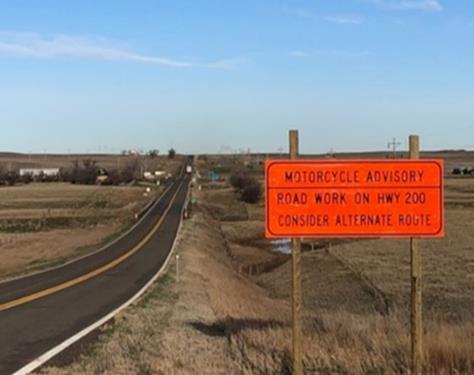
Motorcycle advisory sign on Montana Highway 200. (Source: Jeremy Wilde, Montana DOT)
Motorcycles comprise only 3 percent of registered vehicles and 0.6 percent of vehicle miles traveled. But, more than 5,500 motorcyclists were killed in traffic crashes in 2020, accounting for 14 percent of motor vehicle traffic fatalities. It is clear that motorcyclists' safety issues must be addressed if we want to achieve the goal of zero fatalities, and efforts must be made to ensure that our transportation system is designed and operated to provide safe mobility for all road users.
To address this challenging safety issue, FHWA has been leading a Motorcycle Safety Program to conduct research and to provide technical assistance, outreach and education, and resources to States on a variety of important motorcycle safety topics. One of the most recent efforts is the development of Motorcycle Safety Noteworthy Practices: Infrastructure and Engineering. These noteworthy practices aim to transfer roadway infrastructure countermeasures that researchers have examined, and that State and local agencies have used to improve motorcyclist safety, to practitioners so that more agencies can broadly implement the countermeasures.
The noteworthy practices contain summaries on nine infrastructure-based countermeasures that address specific road and barrier design, pavement design and construction, and maintenance issues related to motorcycles. The nine noteworthy practices include:
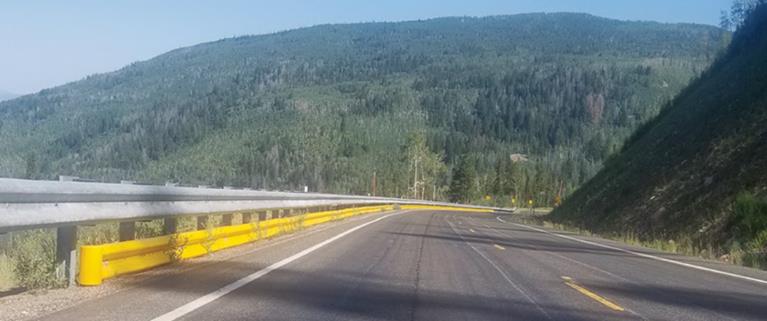
Motorcycle attenuator installed in Utah. (Source: Utah DOT)
Detailed information on these nine motorcycle safety noteworthy practices can be accessed at https://safety.fhwa.dot.gov/motorcycles/docs/FHWA_MAC_Recommendations_Project_Noteworthy_Practices.pdf. FHWA will continue working with transportation agencies and safety stakeholders to promote and implement effective safety countermeasures for motorcyclists. For other FHWA motorcycle safety resources, please check out FHWA's Motorcycle Safety Program website.
For more information, please contact Guan Xu at guan.xu@dot.gov.
By Joseph Cheung, P.E., FHWA Office of Safety
Improving Pedestrian Safety During Nighttime Travel
FHWA created Research Report: Street Lighting for Pedestrian Safety to provide lighting recommendations for pedestrian safety. In developing the lighting recommendations, FHWA considered the ability of pedestrians to detect hazards on walkways and crosswalks, visibility of pedestrians to motorists, and impacts of lighting on pedestrian decisions about whether or not to cross a roadway.
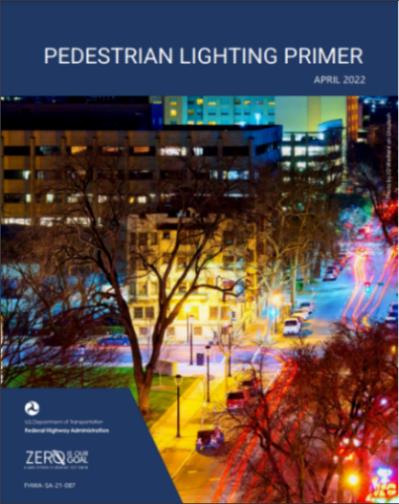
Cover of Pedestrian Lighting Primer. (Source: FHWA)
FHWA also recently published the user-friendly companion document Pedestrian Lighting Primer as a resource for transportation practitioners interested in lighting. The primer provides information for the safety and security of pedestrians. The primer highlights how the results from Street Lighting for Pedestrian Safety can complement commonly used lighting design guides. The primer presents an overview of a four-step process that involves selecting design criteria, selecting equipment, determining the control strategy, and conducting lighting design and verification. As the primer illustrates, lighting of pedestrian facilities is key to increasing the safety performance of the roadway network for all users. Effective pedestrian lighting is a means of addressing the vulnerability of pedestrians during dark conditions and improving the safety and security of all road users spanning different ages and abilities. The Pedestrian Lighting Primer, along with Street Lighting for Pedestrian Safety, can help transportation practitioners realize the benefits of lighting designs and provide safer facilities for pedestrians at night.
An additional resource related to the primer is Lighting for Pedestrian Safety. This two-pager summarizes key elements from the primer and brings to the forefront all other impacts on providing a well-lit street environment.
New Resources for Keeping Vehicles in Lanes
HFST is a Proven Safety Countermeasure for reducing friction-related crashes at curves, ramps, intersections, and locations with high friction demand. Over the past 15 years, more than 44 States have deployed HFST for the first time, with many States currently implementing HFST systemically on a large scale. The state of the practice for HFST site selection, materials, installation, and performance monitoring has changed significantly since HFST first became an Every Day Counts safety initiative.

Cover of High Friction Surface Treatment Site Selection and Installation Guide. (Source: FHWA)
High Friction Surface Treatment Site Selection and Installation Guide is a new resource that reflects these changes. This guide assists agencies implementing HFST for the first time that may be limited in their ability to expand and improve their programs, and that may have mature programs they would like to further refine. The guide highlights key practices from agencies that have realized the greatest benefit from HFST deployment (including data-driven approaches for site selection); addresses testing requirements; and provides recommendations on contracting practices, installation methods, and performance monitoring.
HFST Installation and Inspection Pocket Guide summarizes chapter 6 of the High Friction Surface Treatment Site Selection and Installation Guide. This pocket guide may be downloaded, printed, or viewed on mobile devices in the field. The pocket guide includes an inspection checklist that steps through preconstruction, materials, surface preparation, pre-application, resin binder application, aggregate application, aggregate removal, traffic and testing acceptance opening, and post-installation items.
FHWA High Friction Surface Treatments: Frequently Asked Questions – 2022 Update has been updated from the 2017 HFST FAQs. It provides concise answers to the more commonly asked questions related to HFST. This includes questions about safety, maintenance and operations, cost, environmental impacts, material specifications/durability, lessons learned, and installation.
HFST Training Materials have also been updated using the above new resources. They are available with scripted speaker notes, designed for up to 4 hours of training. To schedule the delivery of this training module, please contact Victoria Brinkly at Victoria.brinkly@dot.gov.
For more information about these resources, please contact Joseph Cheung at joseph.cheung@dot.gov.
By Jeffrey B. Shaw, P.E., FHWA Office of Safety
The share of bicyclist and pedestrian fatalities and serious injuries that occurs at intersections is notable. Based on data from the National Highway Traffic Safety Administration, from 2015 to 2019, an estimated 57 percent of bicyclist and 39 percent of pedestrian fatalities and incapacitating injuries occurred at intersections or were related to intersections.
Compared to people traveling in motor vehicles, pedestrians and bicyclists are typically at greater risk of casualty in the event of a crash. Therefore, it is even more critical that planning, design, and operation of intersections account for the most vulnerable. When designed with pedestrians and bicyclists explicitly in mind, all types of intersections can facilitate safe, accessible, convenient, and comfortable walking and bicycling.
This was the motivation for a new guide, Improving Intersections for Pedestrians and Bicyclists, recently published by FHWA. This guide is a supplement to the preceding series of informational intersection guides and makes direct connections to other bikeway and pedestrian facility selection guides.
The pursuit of eliminating deaths and serious injuries on our Nation's roads relies on the Safe System Approach as an integral tool for reaching this goal. At intersections, this involves minimizing risks to all road users by applying a kinetic energy management model. The model relies on design features that lower vehicle speeds, separate road users, remove conflict points, and reduce conflict point severity. To varying degrees, both traditional and innovative/alternative intersection designs may exhibit some or all of these kinetic energy management model characteristics. The new guide represents a holistic approach to combining innovative/alternative intersection designs with the Safe System Approach, complete streets, Proven Safety Countermeasures, and facility selection best practices to help agencies create walkable and bikeable intersections that are safer for all users.

Three principles for planning and designing intersections. (Source: FHWA)
Three key principles ground the guide and set the stage for planning and designing intersections for pedestrians and bicyclists:
The guide is heavy on graphic representations of the key principles and concepts, as reflected in the figure to the right. In addition to graphics for different intersection types, there is also discussion on assessment techniques for identifying and characterizing conditions that impact pedestrians and bicyclists. The assessment techniques discussed in the guide include:
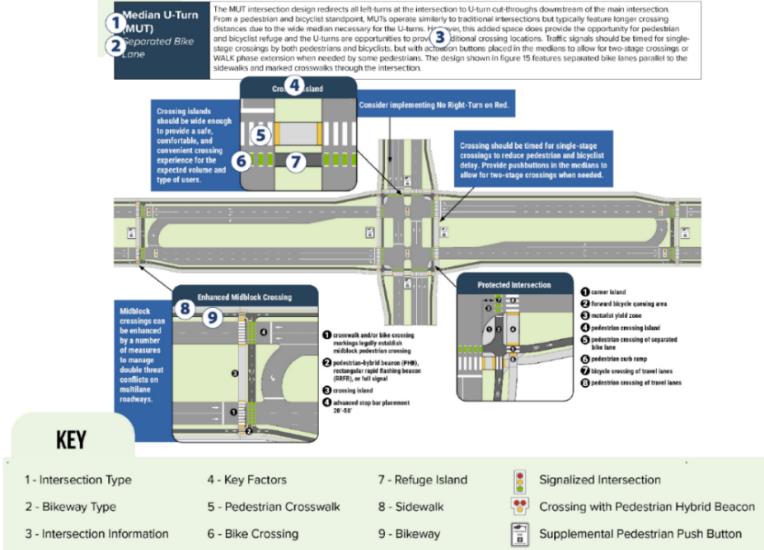
Graphic from Improving Intersections for Pedestrians and Bicyclists. (Source: FHWA)
Finally, at the end of the guide a section is devoted to resources for additional information and a valuable list of references published by FHWA, NCHRP, AASHTO, Institute of Transportation Engineers, and National Association of City Transportation Officials. There is also a companion series of one-page fact sheets suitable for printing and handing out at public meetings, exhibit booths, and similar forums.
For more information, please contact Jeff Shaw at Jeffrey.shaw@dot.gov.
By Tamara Redmon, FHWA Office of Safety
In an effort to improve safety for pedestrians and bicyclists accessing transit, the Federal Highway Administration (FHWA) and Federal Transit Administration (FTA) have released a new guide, which includes a variety of approaches to address common safety issues that are likely to arise near transit stations, bus stops and other places where transit (bus or rail) is operated.
The new guide, Improving Safety for Pedestrians and Bicyclists Accessing Transit, provides agencies with a thorough look at pedestrian and bicyclist safety considerations in accessing and using transit. The guide can help transit agencies, state and local roadway owners, and regional organizations by providing a comprehensive understanding of how to address pedestrian and bicyclist safety concerns related to accessing transit.
Additional resources and information on FHWA efforts to improve safety for all road users can be found here. For further information, please contact Tamara Redmon at tamara.redmon@dot.gov.
By Danielle Betkey, FHWA Office of Safety
The 2020 State safety performance target assessments results are now available. New this year, and to help elevate the safety performance target results, FHWA added a link to enable users to download a file of all the States' data. These data were added to support NRSS, a comprehensive approach to significantly reduce serious injuries and deaths for all road users.
For more information, please contact Danielle Betkey at Danielle.Betkey@dot.gov.
By Cathy Satterfield, FHWA Office of Safety
In early August, FHWA released a final rule that amends the Manual on Uniform Traffic Control Devices (MUTCD) to include minimum requirements for pavement marking retroreflectivity. Like the current MUTCD sign retroreflectivity requirements, compliance with the pavement marking retroreflectivity requirements is based on having an appropriate maintenance method in place. A compliance date 4 years from the effective date of the final rule can be found in the Introduction to the MUTCD. See Section 3A.03 of the MUTCD for the standard, guidance, options, and support. There is also additional information on the rulemaking, which can be found in revision 3 of the 2009 MUTCD. This revision includes new provisions for maintaining minimum levels of retroreflectivity for pavement markings. It can be found online here.
For more information, please contact Cate Satterfield at cathy.satterfield@dot.gov.
By Chimai Ngo, FHWA Office of Safety
Transportation safety boils down to people. People who use the road system, design, build and deploy safety treatments. We want to feature your safety story.
Do you have a story to share or know someone in your organization whose life was saved by safety treatments or whose career was inspired by a safety story?
If so, please contact Chimai Ngo at chimai.ngo@dot.gov.
Intelligent Transportation Systems (ITS) World Congress
ITS World Congress will be held September 18–22, 2022, in Los Angeles, CA.
National Safety Council (NSC) Safety Congress & Expo
2022 NSC Safety Congress & Expo will be hosted September 19–21, 2022, in San Diego, CA.
25th IEEE International Conference on Intelligent Transportation Systems (ITSC)
25th IEEE ITSC conference will be hosted October 8–12, 2022, in Macau, China.
American Public Transportation Association (APTA) TRANSform Conference
APTA's TRANSform Conference will be hosted October 9–12, 2022, in Seattle, WA.
International Conference on Transportation and Safety
Hosted by the World Academy of Science, Engineering and Technology, the International Conference on Transportation and Safety will be hosted October 13–14, 2022, in London.
AASHTO Annual Meeting will be held October 19–23, 2022, in Orlando, FL.
American Society of Civil Engineers (ASCE) 2022 Convention
ASCE 2021 Convention will be hosted October 23–26, 2022, in Anaheim, CA.
National League of Cities (NLC) City Summit
NLC City Summit will be hosted November 17–19, 2022, in Kansas City, MO. Preconference activities and executive education sessions begin November 16, 2022.
2023 Annual Transportation Research Board (TRB) Annual Meeting
TRB 102nd Annual Meeting will be held January 8–13, 2023, in Washington, DC.
is a publication of the U.S. Department of Transportation, Federal Highway Administration (FHWA).
FHWA publishes the Safety Compass newsletter 3 times a year. We can be reached at:
FHWA Office of Safety
1200 New Jersey Ave. SE
Room E71-320
Washington, DC 20590
The Safety Compass is available online at the FHWA Office of Safety web site at: https://safety.fhwa.dot.gov/newsletter/safetycompass/.
We welcome your comments and highway safety-related articles. The purpose of this newsletter is to increase highway safety awareness and information and to provide resources to help save lives.
We encourage readers to submit highway safety articles that might be of value to the highway safety community. Send your comments, questions, and articles for review electronically to Tara McLoughlin at: tara.mcloughlin@dot.gov.
